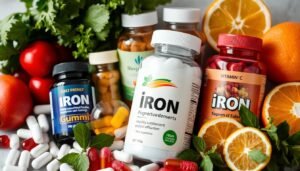1. Dietary Changes and Supplements
Iron-deficiency anemia is a common condition caused by a lack of sufficient iron, which is needed for producing hemoglobin. A primary approach to treating this condition is through dietary changes and iron supplementation, both of which can help increase iron levels and alleviate anemia symptoms.
Iron-Rich Foods: Incorporating iron-rich foods into the diet is essential for replenishing iron stores. Some excellent sources of iron include lean meats, poultry, fish, beans, lentils, tofu, and fortified cereals. Regularly consuming these foods can support the body’s ability to produce hemoglobin. Additionally, pairing iron-rich foods with vitamin C sources, like oranges, strawberries, bell peppers, and broccoli, enhances iron absorption.
Iron Supplements: In cases where dietary sources alone aren’t enough, healthcare providers may recommend iron supplements such as ferrous sulfate, ferrous gluconate, or ferrous fumarate. It’s essential to follow the prescribed dosage to avoid potential side effects and ensure proper absorption. For best results, supplements are ideally taken on an empty stomach or with vitamin C-rich foods. Consulting a healthcare provider before beginning any supplement is crucial to personalize the treatment approach.
Inhibitors of Iron Absorption: People with anemia should also consider factors that may inhibit iron absorption. Substances like tannins, found in tea and coffee, can reduce the absorption of non-heme (plant-based) iron. Limiting consumption of these beverages around mealtimes can help improve iron uptake from food.
2. Iron Supplementation and Types of Iron
Iron is a vital component in treating iron-deficiency anemia. The main focus is to ensure adequate iron intake from dietary sources or supplements. Iron supports hemoglobin production, which carries oxygen from the lungs to the rest of the body.
Types of Iron: There are two main forms of dietary iron: heme iron (from animal sources like red meat, poultry, and fish) and non-heme iron (from plant sources like beans, lentils, spinach, and fortified cereals). Heme iron is absorbed more easily than non-heme iron. Consuming vitamin C with non-heme iron sources can further enhance absorption.
Supplementation: For those whose dietary changes aren’t sufficient, iron supplements, either over-the-counter or prescription, may be necessary. It’s essential to follow medical guidance on dosage and timing to maximize absorption and minimize side effects, such as constipation or nausea. For individuals who cannot tolerate oral supplements or have severe deficiencies, other forms of iron therapy may be considered.

3. Vitamin C for Enhanced Iron Absorption
Vitamin C, or ascorbic acid, is essential for improving the absorption of non-heme iron from plant-based foods and supplements. By consuming vitamin C-rich foods alongside iron sources, individuals can increase iron absorption.
Vitamin C Sources: Citrus fruits (like oranges and grapefruits), strawberries, kiwi, bell peppers, and broccoli are excellent sources of vitamin C. In addition to helping with iron absorption, vitamin C acts as an antioxidant, supporting overall health and cellular protection.
Timing of Intake: For those with iron-deficiency anemia, it’s beneficial to consume vitamin C with non-heme iron sources like leafy greens or legumes to improve absorption. However, calcium-rich foods or drinks should be avoided simultaneously as they may inhibit non-heme iron absorption.
4. Treatment to Stop Bleeding
If iron-deficiency anemia is due to chronic bleeding, addressing the source of bleeding is critical.
Medications: Antifibrinolytic agents, which promote clot formation, can reduce blood loss by preventing the breakdown of blood clots.
Surgical Interventions: For bleeding from gastrointestinal ulcers, tumors, or other abnormalities, surgical procedures may be needed to repair or remove the affected area. Surgery may be considered if other measures fail to control bleeding or in cases of life-threatening hemorrhage.
Minimally Invasive Procedures: In some cases, endoscopic therapy or embolization may be used to control internal bleeding. Endoscopic therapy involves using specialized tools to treat abnormalities directly, while embolization selectively blocks off blood vessels responsible for bleeding.

5. Treatments for Severe Iron-Deficiency Anemia
Severe iron-deficiency anemia may require more aggressive treatments to restore iron levels quickly.
Intravenous (IV) Iron Therapy: For those who cannot tolerate oral supplements, IV iron therapy provides iron directly into the bloodstream, allowing rapid replenishment of iron stores.
Erythropoietin-Stimulating Agents (ESAs): These agents stimulate red blood cell production and are often reserved for individuals with chronic kidney disease or those undergoing chemotherapy.
Blood Transfusion: In cases of severe anemia, a blood transfusion may be necessary to increase red blood cell count rapidly. This intervention is usually reserved for individuals experiencing significant symptoms or complications.
6. Blood Transfusion for Severe Anemia
Blood transfusions are sometimes essential for severe cases of iron-deficiency anemia, especially when there’s significant blood loss or risk of complications.
Purpose: Blood transfusions quickly restore hemoglobin levels and improve oxygen delivery to the body, alleviating symptoms such as fatigue, weakness, and shortness of breath.
Monitoring for Safety: Healthcare providers closely monitor patients during transfusions to manage any potential side effects, such as allergic reactions or transfusion-related complications. With proper supervision, blood transfusions can be life-saving for individuals with severe iron-deficiency anemia.
7. Iron Therapy Options
Iron therapy aims to replenish the body’s iron stores and address anemia.
Oral Supplements: Iron supplements such as ferrous sulfate and ferrous gluconate are commonly recommended. These are usually taken on an empty stomach to enhance absorption, although they can sometimes cause gastrointestinal side effects.
Intravenous Iron Therapy: For individuals unable to tolerate oral supplements or with significant deficiencies, IV iron therapy may be an effective option, allowing for faster absorption and utilization of iron.
Adherence and Monitoring: Following the full course of prescribed supplements, even after hemoglobin levels normalize, is essential for completely restoring iron stores. Regular blood tests help healthcare providers monitor the effectiveness of treatment and make any necessary adjustments.
Conclusion
The treatment of iron-deficiency anemia involves a multifaceted approach, depending on the underlying cause and severity of the condition. Dietary changes and supplements are foundational, with a focus on consuming iron-rich foods and pairing them with vitamin C for enhanced absorption. For those with bleeding-related anemia, addressing the root cause of bleeding is critical, whether through medication, surgery, or minimally invasive procedures.
In severe cases, IV iron therapy, erythropoietin-stimulating agents, and blood transfusions may be necessary to rapidly restore iron levels. With proper medical guidance and commitment to treatment, individuals can experience significant symptom relief and overall improvement in health.